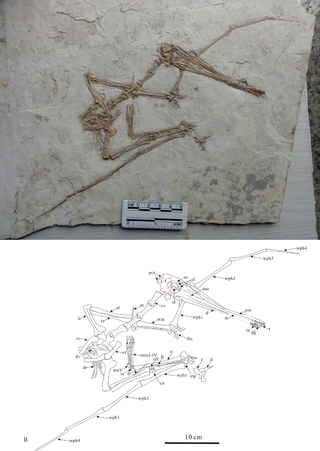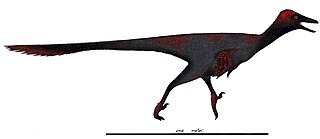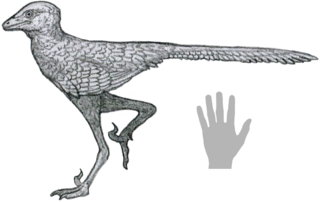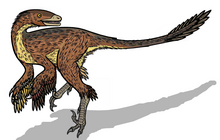
Troodontidae is a clade of bird-like theropod dinosaurs. During most of the 20th century, troodontid fossils were few and incomplete and they have therefore been allied, at various times, with many dinosaurian lineages. More recent fossil discoveries of complete and articulated specimens, have helped to increase understanding about this group. Anatomical studies, particularly studies of the most primitive troodontids, like Sinovenator, demonstrate striking anatomical similarities with Archaeopteryx and primitive dromaeosaurids, and demonstrate that they are relatives comprising a clade called Paraves.

Mei is a genus of duck-sized troodontid dinosaur first unearthed by paleontologists from the Yixian Formation in Liaoning, China in 2004. Mei lived during the Early Cretaceous period. The binomial name of its only species, Mei long, means sleeping dragon.

Byronosaurus is a genus of troodontid dinosaur from the Late Cretaceous Period of Mongolia.

Sinornithoides is a genus of troodontid theropod dinosaurs containing the single species Sinornithoides youngi. S. youngi lived during the Early Cretaceous. It measured approximately one meter long (3.3 ft). It lived in Inner Mongolia, China, and probably ate invertebrates and other small prey. They lived in what is now Mongolia, which was part of Laurasia.

Sinovenator is a genus of troodontid dinosaur from China. It is from the early Cretaceous Period.

Liaoningosaurus is an unusual genus of basal ankylosaurid dinosaur from the Liaoning Province, China that lived during the Early Cretaceous in what is now the Yixian and Jiufotang Formation. The type and only species, Liaoningosaurus paradoxus, is known from more than 20 specimens, with some representing juveniles. It was named in 2001 by Xu, Wang and You.

Jeholosaurus is a genus of neornithischian dinosaur from the Early Cretaceous Period. It is thought to have been a herbivorous small ornithopod.

Graciliraptor is a genus of theropod dinosaur from the early Cretaceous Period. It is a microraptorine dromaeosaurid.

Xixiasaurus is a genus of troodontid dinosaur that lived during the Late Cretaceous Period in what is now China. The only known specimen was discovered in Xixia County, Henan Province, in central China, and became the holotype of the new genus and species Xixiasaurus henanensis in 2010. The names refer to the areas of discovery, and can be translated as "Henan Xixia lizard". The specimen consists of an almost complete skull, part of the lower jaw, and teeth, as well as a partial right forelimb.

Gladocephaloideus is a genus of ctenochasmatid ctenochasmatoid pterosaur from the Early Cretaceous period of what is now western Liaoning, China.

Philovenator is an extinct genus of troodontid paravian dinosaurs from the Wulansuhai Formation of Inner Mongolia, China. Its specific name honors Phillip J. Currie.

Moganopterus is an extinct genus of ctenochasmatid pterosaur from the Early Cretaceous of western Liaoning Province, China.
Hexing is an extinct genus of basal ornithomimosaur dinosaur known from the Early Cretaceous of northeastern China. It contains a single species, Hexing qingyi.

Jianchangosaurus is a genus of therizinosaurian dinosaur that lived approximately 126 million years ago during the early part of the Cretaceous Period from the Yixian Formation in what is now China. The nearly complete juvenile specimen was missing only the distal tail. Jianchangosaurus was a small, lightly built, bipedal, ground-dwelling herbivore, that could grow up to an estimated 2 m (6.6 ft) long and was 1 m (3.3 ft) high at the hips.

Gobivenator is an extinct genus of troodontid theropod dinosaur known from the late Campanian Djadokhta Formation of central Gobi Desert, Mongolia. It contains a single species, Gobivenator mongoliensis. G. mongoliensis is known from a single individual, which represents the most complete specimen of a Late Cretaceous troodontid currently known.

Chuanqilong is a monospecific genus of basal ankylosaurid dinosaur from the Liaoning Province, China that lived during the Early Cretaceous in what is now the Jiufotang Formation. The type and only species, Chuanqilong chaoyangensis, is known from a nearly complete skeleton with a skull of a juvenile individual. It was described in 2014 by Fenglu Han, Wenjie Zheng, Dongyu Hu, Xing Xu, and Paul M. Barrett. Chuanqilong shows many similarities with Liaoningosaurus and may represent a later ontogenetic stage of the taxon.

Jianianhualong is a genus of troodontid theropod dinosaur from the Early Cretaceous of China. It contains a single species, Jianianhualong tengi, named in 2017 by Xu Xing and colleagues based on an articulated skeleton preserving feathers. The feathers at the middle of the tail of Jianianhualong are asymmetric, being the first record of asymmetrical feathers among the troodontids. Despite aerodynamic differences from the flight feathers of modern birds, the feathers in the tail vane of Jianianhualong could have functioned in drag reduction whilst the animal was moving. The discovery of Jianianhualong supports the notion that asymmetrical feathers appeared early in the evolutionary history of the Paraves.

Daliansaurus is a genus of small troodontid theropod dinosaur, measuring approximately 1 metre long, from the Early Cretaceous of China. It contains a single species, D. liaoningensis, named in 2017 by Shen and colleagues from a nearly complete skeleton preserved in three dimensions. Daliansaurus is unusual in possessing an enlarged claw on the fourth digit of the foot, in addition to the "sickle claw" found on the second digit of the feet of most paravians. It also has long metatarsal bones, and apparently possesses bird-like uncinate processes. In the Lujiatun Beds of the Yixian Formation, a volcanically-influenced region with a cold climate, Daliansaurus lived alongside its closest relatives - Sinovenator, Sinusonasus, and Mei, with which it forms the group Sinovenatorinae.

Liaoningvenator is a genus of troodontid theropod dinosaur from the Early Cretaceous of China. It contains a single species, L. curriei, named after paleontologist Phillip J. Currie in 2017 by Shen Cai-Zhi and colleagues from an articulated, nearly complete skeleton, one of the most complete troodontid specimens known. Shen and colleagues found indicative traits that placed Liaoningvenator within the Troodontidae. These traits included its numerous, small, and closely packed teeth, as well as the vertebrae towards the end of its tail having shallow grooves in place of neural spines on their top surfaces.

Caihong is a genus of small paravian theropod dinosaur from China that lived during the Late Jurassic period.




















